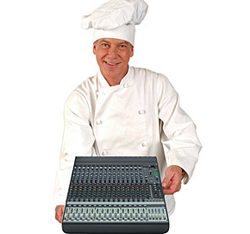It takes the right blend of quality ingredients and salient directions to produce the best results from any recipe.
If a dessert recipe calls for cream, it’s not essential to use Alpine milk from hand-milked Bavarian cows, but using skim milk instead of cream may jeopardize the final results.
The same holds true for sound reinforcement. A microphone for a singing vocalist that’s substituted with a pulpit microphone designed for spoken word simply isn’t the right ingredient for the recipe. It won’t help attain the desired result.
The bottom line is that all sound system components should be of as high of quality as possible. There also needs to be an understanding of the expectations of those who are going to taste the results. For example, a chef may like extra spicy food.
But when preparing food for others, the chef must take into consideration the guests for whom the food is being prepared, and may need to slightly vary the recipe. Further, and absolutely vital: before using any recipe, the sound operator must communicate with everyone involved with a performance, both spoken word and musical.
They must understand that a given recipe may take several attempts before it produces the desired results. This process requires extra time, effort and patience on everybody’s part.
Just as you wouldn’t start a food recipe 10 minutes before it needs to be served, don’t wait for dress rehearsals or worship services to start building your sound mix.
Vital point: Always seek natural acoustical solutions before adding more sound reinforcement, i.e., system components and increasing volume levels. Too much can lead to a big mess!
Multiple Layers
Let’s start with the basics. It’s vital to understand the acoustical elements of the sound mix and their effect on each other.
Think of it as a multi-layer cake. This represents the concept that each layer builds on the other, while they all work together to create a desired outcome.
It should be pointed out that all of these layers might not be used or needed. However, the principles remain the same.
The amount of ambient noise in the room establishes the base layer of sound. In other words, the air system, conversations, people moving, etc., create noise the sound system must overcome. Ambient noise will also change overall levels. For example, an empty room is much quieter than one filled with people.
The second layer consists of acoustical instruments. It’s important to first begin with main instrument(s) like acoustical piano and/or guitar(s), then add drums, and finally, any other acoustical instruments.





















